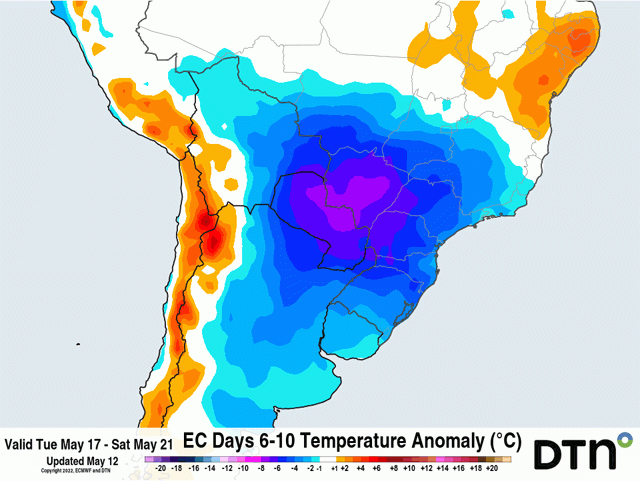South America Calling
Southern Brazil Frost Potential Is Growing Concern for Safrinha Corn
Dryness across central Brazil has been noted for quite some time and is likely to have an impact on safrinha (second-crop) corn production as soil moisture has become critical.
Southern Brazil has fared much better so far this season, seeing a significant increase in showers in March and April and turning drought conditions into an abundance of soil moisture. Crop health estimates, as measured by Normalized Differential Vegetation Index (NDVI) from satellite data, suggest that the safrinha corn crop from Mato Grosso do Sul through Parana is excellent for this time of year.
The National Supply Company (CONAB) in Brazil increased its total corn estimates from 115.6 million metric tons (mmt) to 116.2 mmt, owing to increases in acreage due to strong market incentives and better weather across the southern states of Parana and Mato Grosso do Sul. That was enough to offset decreases in production to the north.
The USDA, in its May World Agricultural Supply and Demand Estimates report, left Brazil corn production unchanged from its April estimate of 116 mmt.
P[L1] D[0x0] M[300x250] OOP[F] ADUNIT[] T[]
But weather challenges for the rest of the season could cause production estimates to fall. Drought is certainly one of those factors and it remains to be seen how much of an impact it will have on central Brazil's production. But one that is more specific to southern states that are in good health would be risks for frost.
La Nina continues to have a grip on ocean temperatures in the tropical Pacific Ocean. The forecast continues to suggest that La Nina conditions will continue into Southern Hemisphere summer, potentially weakening going into 2023. That means La Nina's influence will continue through the rest of the safrinha season and affect the beginning of next season as well.
La Nina's influence in South America for this time of year is to increase jet stream energy, creating stronger storm systems that push deeper north into Brazil. Without much available moisture, showers over central Brazil are still pretty rare and isolated. However, the lower temperatures that are brought northward penetrate farther than in other years. This can lead to increased frost risks for the southern states of Mato Grosso do Sul, Parana and Rio Grande do Sul. Sometimes, the depth of the cold is enough to penetrate up into southern Mato Grosso, Goias, and Minas Gerais as well. That happened on three occasions last winter, having a devastating impact on safrinha corn.
Although corn was planted within the optimum window, the frost risk remains genuine. Usually, the greatest risks for frost occur in June and July at the tail end of the safrinha corn season when planting occurs on time. Risks to the crop are then limited to those that are planted very late. This year, however, there appears to be a significant frost risk next week in mid-May.
A system will move through Argentina May 13-14, sending its cold front through southern Brazil and Paraguay during the weekend with scattered showers, and into central Brazil early next week with only spotty, isolated showers. Cold air pouring northward next week will set the stage for potential frosts across southern Mato Grosso do Sul, Parana, Sao Paulo and points south for at least a few days between May 16 and May 21. Cloud cover and winds will need to be taken into account, but a couple of days could see frosts and even freezes, with temperatures falling down to minus 2 Celsius (28 Fahrenheit). There is even potential for southern Minas Gerais to become cold enough for frosts. Crop damage would certainly be the case, and could have an impact on coffee, cocoa and sugarcane crops in Sao Paulo and southern Minas Gerais as well.
The government of Parana released a report on May 9 that indicated that 15% of the safrinha corn crop was still vegetative, 41% was pollinating, another 41% was filling grain, and only 3% was mature. That leaves the vast majority of the crop at significant risk at frost damage should temperatures fall below freezing.
The long-range version of the European model indicates that colder temperatures may stick around through June, giving additional risks of frost for southern Brazil. Should crop losses occur, that would be the second year in a row of significant frost damage due to La Nina.
To find more international weather conditions and your local forecast from DTN, head over to https://www.dtnpf.com/…
John Baranick can be reached at john.baranick@dtn.com
(c) Copyright 2022 DTN, LLC. All rights reserved.





Comments
To comment, please Log In or Join our Community .